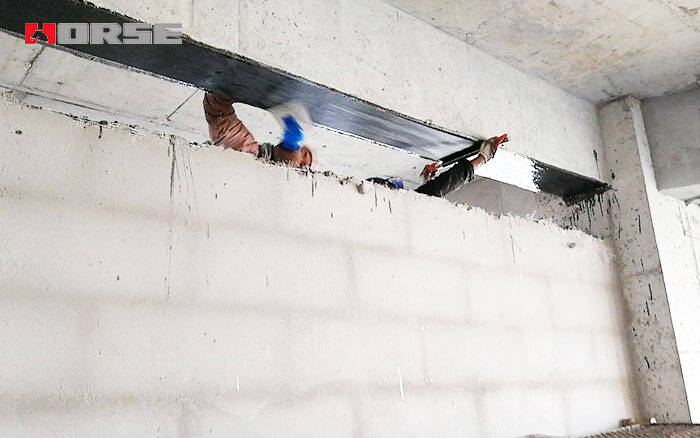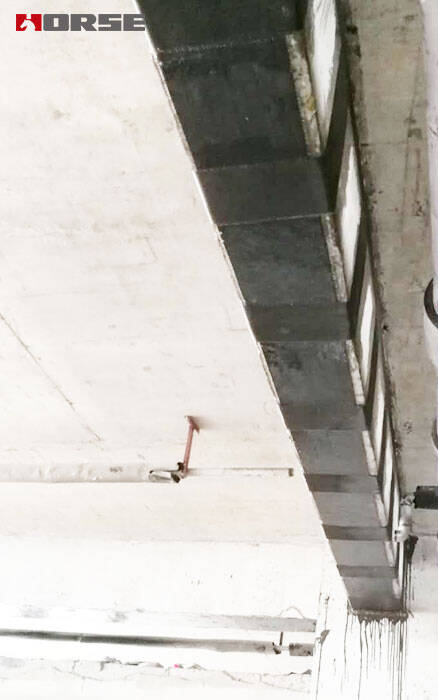Reinforcement of frame beams on the first floor
New East billion locomotive complex
Because of the change of the function of the building, some small cracks appear after the increase of the load on the beam. In order to ensure the bearing quality of the whole structure, it is necessary to reinforce the beam-related structure with fiber reinforced polymer(FRP).

Engineering survey
Project Name: new Dongyi project
Project location: Nanjiang County, Bazhong, Sichuan
Engineering contents: beam crack repair and FRP reinforced concrete beam
Reason
Because of the change of the function of the building, some small cracks appear after the increase of the load on the beam. In order to ensure the bearing quality of the whole structure, it is necessary to reinforce the beam-related structure with fiber reinforced polymer(FRP).
Repair technology for cracks and bonding carbon fiber reinforced polymer(CFRP)
Concrete repair
Base treatment (cleaning cracks): grinding the beams with angle grinder coatings and mortar in the use of steel wire brushing is more crack surface, cracks in the case of dust, with a high-pressure blower to blow out the crack dust, along the crack on both sides of the concrete with a cloth to wipe dust.
Paste grouting nozzle: The grouting nozzle is pasted on the crack with sealant seam. The base grouting nozzle is required to align with the crack, and the bottom seating is required to be firmly pasted without leakage of glue. The base spacing is about 20mm - 30mm. According to the width of the crack site.
Closed cracks: sealing cracks with plastic sealing all except the grouting mouth, width 20mm - 30mm.
Dispensing: fill the crack injection into the glue dispenser and tighten the glue applicator to the bottom.
Glue filling: loosen the glue dispenser, confirm the injection state, if the glue is insufficient, then add the injection.
Completion of injection: After the injection rate is reduced and no more glue is added, the glue filler can be removed and plugged with the plug slurry bottom.
After the pouring glue is solidified, knock off the base and plug, clean the surface.
After cleaning the surface, the beams are polished and the next working procedure is carried out.

Sticky carbon fiber(FRP) reinforcement
(1) cleaning concrete beam surface
Deteriorated concrete such as spalling, loosening, honeycomb, protrusion and corrosion on the surface of concrete beams are removed by electric grinding wheel to expose the concrete structure layer.
(2) wire location:
According to the design, the range of CFRP reinforcement should be ejected with ink line, calibrated from top to bottom, demarcated according to the design size from both ends of heel to middle. If the division is not an integer, the space should be adjusted and the size should not be greater than the design size.
(3) surface grinding
The surface of the concrete pasted with CFRP sheets must be solid. After removing the poor quality such as slurry layer and stainless, the concrete should be polished smoothly, and the smoothness should reach 5m m/m. The component should be polished into an arc outside the corner pasted, and the arc radius should not be less than 20m M. After the surface is polished, the surface dust can be thoroughly removed by using a powerful blower or a dust suction running dragon.
(4) purification treatment
After bonding the carbon fiber surface of the concrete to the rough surface, it must be cleaned with cotton yarn and industrial acetone.
(5) leveling treatment
1. The leveling material should be allocated according to the technological regulations provided by the product manufacturer.
2. Leveling material should be used to fill the concave part of concrete surface, and there should be no edges and corners;
3. At the corner, the leveling material should be repaired to be a smooth circular arc with a radius of not less than 20mm;
4. When the surface of the leveling material is touched and dried, the next construction process shall be carried out immediately.
(6) tailoring carbon fiber cloth
Carbon fiber cloth can be cut with scissors or artistic knives according to the design requirements. The integrity of longitudinal fiber of carbon cloth should be guaranteed. Carbon cloth cut according to the design size should be strictly prohibited from folding. Carbon cloth should be stored straight to avoid warping and deformation. Dust and oil stains should not be adhered.
(7) carbon fiber cloth
1. Carbon fiber adhesive should be prepared according to the technological regulations provided by the manufacturer, and should be evenly applied to the adhesive part.
2. The overlap length of CFRP along the stress direction of CFRP should not be less than 200 mm, and the overlap positions of CFRP sheets or laminates should be staggered.
3. The special drum is used to roll along the fiber direction for many times to extrude bubbles, so that the overlapping positions of carbon fiber sheets are staggered.
4. The above steps should be repeated in multi-layer pasting, and the lower layer should be pasted as soon as possible after the carbon fiber adhesive on the carbon fiber surface touches the dry.
Process quality inspection
(1) Carbon fiber cloth should be clean, no wrinkles, fiber arrangement uniform, continuous, no broken wire, knot, etc.
(2) the appearance and color of carbon cloth adhesive are uniform, no caking and no stratified precipitation.
Examination method: observation
(3) surface inspection after grinding and dressing.
Inspection method: the touch ruler is smooth and has good record.
(4) The bonded CFRP sheet should be fully flattened without wrinkles and air drums. The effective bonding area between CFRP sheet and concrete should not be less than 95% of the total bonding area. The single empty drum area less than 10 000 mm2 can be repaired by injection method. Single empty drum area less than 10000mm2, should be cut and repaired, re-pasted and other quality fiber cloth, and the length of multilateral lap should not be less than 150mm.
(5) The impregnated adhesive should be dipped into the surface of carbon fiber cloth, and then after surface brushing, there should be a smoother adhesive surface.
Examination method: observation
(6) detection: the national statutory testing body, the anti pull-out test, destructive test - test report.